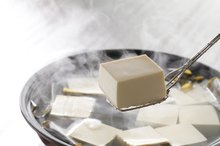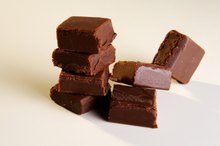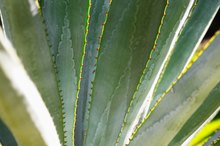What does fact checked mean?
At Healthfully, we strive to deliver objective content that is accurate and up-to-date. Our team periodically reviews articles in order to ensure content quality. The sources cited below consist of evidence from peer-reviewed journals, prominent medical organizations, academic associations, and government data.
The information contained on this site is for informational purposes only, and should not be used as a substitute for the advice of a professional health care provider. Please check with the appropriate physician regarding health questions and concerns. Although we strive to deliver accurate and up-to-date information, no guarantee to that effect is made.
Red Rash on the Cheeks From a Peanut Butter or Honey Allergy
The number of children diagnosed with peanut allergies is on the rise, according to PBS Kids. Peanuts are considered one of the most common foods that cause an allergic reaction in children and adults. Honey is not a common food allergen, but can also cause an allergic reaction. Many food allergy rashes form somewhere on the face, such as on the cheeks within a few minutes after you eat the food. Any adverse reactions that you experience after you eat or touch peanut butter or honey should be reported to your physician.
If you are experiencing serious medical symptoms, seek emergency treatment immediately.
Allergic Contact Dermatitis
If a red rash forms on your cheeks after they’ve been touched by peanut butter or honey, you may be experiencing allergic contact dermatitis. This allergic skin condition is caused by an allergic reaction that occurs when the skin comes into direct contact with a specific substance, according to the American Osteopathic College of Dermatology. Sometimes, the rash develops as soon as contact is made, while in other cases, the skin may not form a rash until 1 to 2 days after the contact. If a rash forms after your cheeks have touched peanut butter or honey, wash the affected area with soap and water and call your doctor.
- If a red rash forms on your cheeks after they’ve been touched by peanut butter or honey, you may be experiencing allergic contact dermatitis.
- If a rash forms after your cheeks have touched peanut butter or honey, wash the affected area with soap and water and call your doctor.
Atopic Dermatitis
Skin Rashes and Allergies to Soy
Learn More
Atopic dermatitis, or eczema, is a common skin allergic reaction from peanut butter and other food allergic reactions. The Asthma and Allergy Foundation of America states that about 1 percent of all children’s visits to the doctor are related to atopic dermatitis 1. It commonly forms on the face after eating peanut butter of honey, if you’re allergic to these products. The rash begins as patches of red, swollen skin that develops into small blisters that are filled with liquid. This condition can also cause the cheeks to become thick and very dry.
- Atopic dermatitis, or eczema, is a common skin allergic reaction from peanut butter and other food allergic reactions.
Hives
When you eat peanut butter or honey, your immune system overreacts to the substances by creating histamine. Histamine is a chemical in the body that causes inflammation, itching and swelling in the skin. Hives that form on the cheeks may appear and disappear without any reason. This condition can develop in various shapes and sizes, but always has defined borders.
- When you eat peanut butter or honey, your immune system overreacts to the substances by creating histamine.
- Hives that form on the cheeks may appear and disappear without any reason.
Treatment
What Causes a Rash on a Baby's Face After Eating?
Learn More
Treating a rash on your cheeks from a peanut butter or honey allergy should be discussed with your doctor. You may be advised to eliminate these foods from your diet. Steroid-based topical medications, such as corticosteroids or hydrocortisone, can help reduce the inflammation and itching from the allergic skin reactions.
Related Articles
References
- Asthma and Allergy Foundation of America: Atopic Dermamatitis
- MedlinePlus: Hives
- Cannon HE. The economic impact of peanut allergies. Am J Manag Care. 2018;24(19 Suppl):S428-S433.
- Gupta RS, Lau CH, Sita EE, Smith B, Greenhawt MJ. Factors associated with reported food allergy tolerance among US children. Ann Allergy Asthma Immunol. 2013;111(3):194-198.e4. doi:10.1016/j.anai.2013.06.026
- American College of Allergy, Asthma & Immunology. Peanut Allergy. Updated March 14, 2019.
- Sicherer SH, Simons FER. Epinephrine for First-aid Management of Anaphylaxis. Pediatrics. 2017;139(3) doi:10.1542/peds.2016-4006
- Jhamnani RD, Frischmeyer-Guerrerio P. Desensitization for Peanut Allergies in Children. Curr Treat Options Allergy. 2016;3(3):282–291. doi:10.1007/s40521-016-0091-3
- American Academy of Allergy, Asthma & Immunology. Everything You Need to Know about Tree Nut Allergy.
- Mennini M, Dahdah L, Mazzina O, Fiocchi A. Lupin and Other Potentially Cross-Reactive Allergens in Peanut Allergy. Curr Allergy Asthma Rep. 2016;16(12):84. doi:10.1007/s11882-016-0668-8
Writer Bio
Diane Marks started her writing career in 2010 and has been in health care administration for more than 30 years. She holds a registered nurse license from Citizens General Hospital School of Nursing, a Bachelor of Arts in health care education from California University of Pennsylvania and a Master of Science in health administration from the University of Pittsburgh.









